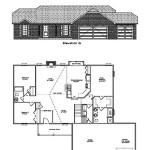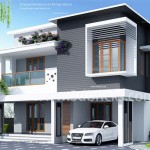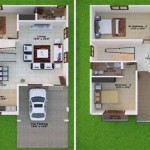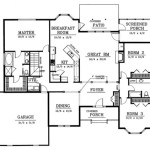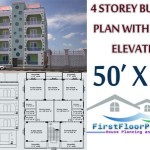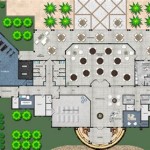Modern Chalet Floor Plans: A Comprehensive Guide
Modern chalet floor plans represent a compelling blend of traditional alpine aesthetics and contemporary design principles. Originally conceived as practical shelters for mountainous regions, chalets have evolved into sophisticated dwellings that prioritize comfort, functionality, and a connection with the natural environment. Modern iterations retain core characteristics while incorporating open-concept layouts, energy-efficient technologies, and expansive glazing to maximize views and natural light.
The design of a modern chalet floor plan is largely dictated by the unique challenges and opportunities presented by the mountainous landscape. Steep slopes, heavy snowfall, and the need to withstand harsh weather conditions necessitate careful consideration of structural integrity and insulation. Simultaneously, the desire to capture panoramic vistas and integrate seamlessly with the surrounding environment drives the incorporation of large windows, terraces, and outdoor living spaces. The resulting architectural form is both aesthetically pleasing and functionally efficient.
Key Considerations in Modern Chalet Floor Plans
Designing a modern chalet requires careful consideration of several key elements to ensure both functionality and aesthetic appeal. The following key points highlight some crucial aspects that influence the successful execution of a modern chalet floor plan:
Optimizing Space and Functionality
Chalet floor plans often emphasize efficient use of space, particularly in areas with limited buildable land. Open-concept living areas are common, combining the kitchen, dining, and living spaces into a single, flowing environment. This promotes social interaction and maximizes the sense of spaciousness. The kitchen, often featuring a central island, serves as a focal point for gathering and culinary activities. Careful attention is paid to storage solutions, ensuring ample space for equipment, supplies, and seasonal items. Mudrooms or entry areas are strategically designed to accommodate boots, coats, and other outdoor gear, preventing clutter from entering the main living areas.
Bedrooms are typically located on upper floors, providing privacy and separation from the main living spaces. Master suites often include en-suite bathrooms and walk-in closets, offering a luxurious retreat. Guest bedrooms are designed to be comfortable and inviting, accommodating visitors with ease. Bathrooms prioritize functionality and aesthetics, incorporating features such as heated floors, spacious showers, and natural materials.
Flexibility is another key consideration in modern chalet design. Rooms may be designed to serve multiple purposes, such as a home office that can be converted into a guest bedroom. Loft spaces can be utilized as play areas, media rooms, or additional sleeping quarters. This adaptability ensures that the chalet can accommodate the changing needs of its occupants over time.
Integrating with the Natural Environment
A hallmark of modern chalet design is its seamless integration with the surrounding natural environment. Large windows and sliding glass doors are strategically placed to maximize views of the mountains, forests, and valleys. These openings also allow ample natural light to flood the interior spaces, reducing the need for artificial lighting. Terraces and balconies extend the living space outdoors, providing opportunities for relaxation, dining, and enjoying the breathtaking views. These outdoor areas are often equipped with fireplaces, outdoor kitchens, and comfortable seating, creating an inviting extension of the interior living space.
The choice of materials plays a crucial role in achieving seamless integration with the natural environment. Natural wood, stone, and other locally sourced materials are commonly used in both the exterior and interior design. These materials not only contribute to the aesthetic appeal of the chalet but also blend harmoniously with the surrounding landscape. Sustainable building practices are often incorporated into the design, minimizing the environmental impact of the construction process.
The orientation of the chalet is carefully considered to maximize solar gain and minimize exposure to harsh weather conditions. South-facing orientations are often preferred to capture sunlight during the winter months, while overhangs and shading devices are used to reduce heat gain during the summer. Proper insulation and ventilation are essential for maintaining comfortable indoor temperatures year-round. Landscaping is also used to enhance the integration with the natural environment, incorporating native plants and trees to create a seamless transition between the chalet and its surroundings.
Addressing Practical and Technical Requirements
The design of a modern chalet floor plan must also address a range of practical and technical requirements. Structural integrity is paramount, given the challenging conditions of mountainous environments. Foundations must be designed to withstand the weight of the building and the effects of frost heave. Roofs must be able to handle heavy snow loads and strong winds. Proper drainage is essential to prevent water damage and erosion.
Energy efficiency is another critical consideration. Chalets are often located in remote areas where access to utilities may be limited or expensive. Therefore, it is important to incorporate energy-efficient technologies and design strategies to minimize energy consumption. This may include features such as solar panels, geothermal heating and cooling systems, and high-performance windows and insulation. Smart home technology can also be used to optimize energy usage and control various aspects of the chalet, such as lighting, heating, and security.
Accessibility is an increasingly important consideration in modern chalet design. Incorporating ramps, elevators, and accessible bathrooms can make the chalet more comfortable and convenient for people of all ages and abilities. This is particularly important for chalets that are intended for use as vacation rentals or retirement homes. Fire safety is another critical consideration, requiring careful planning and the installation of appropriate safety measures, such as smoke detectors, fire extinguishers, and sprinkler systems. The design must also comply with local building codes and regulations.
Common Elements of Modern Chalet Floor Plans
While modern chalet floor plans can vary significantly in size, layout, and style, certain elements are frequently incorporated to enhance both functionality and aesthetic appeal. These common elements contribute to the overall character and charm of the modern chalet:
Open-Concept Living Spaces: As previously mentioned, open-concept layouts are a hallmark of modern chalet design. These spaces create a sense of spaciousness and promote social interaction, making them ideal for entertaining guests or spending time with family. The kitchen, dining, and living areas are typically integrated into a single, flowing environment.
Large Windows and Glazing: Expansive windows and glass doors are used to maximize views and natural light. These openings often extend from floor to ceiling, creating a dramatic connection between the interior and exterior spaces. The use of low-E glass helps to reduce heat transfer and improve energy efficiency.
Natural Materials: Natural wood, stone, and other locally sourced materials are commonly used throughout the chalet. These materials contribute to the aesthetic appeal of the design and blend harmoniously with the surrounding landscape. Wood is often used for structural elements, flooring, and interior finishes, while stone is used for fireplaces, accent walls, and exterior cladding.
Fireplaces: Fireplaces are a traditional element of chalet design, providing warmth, ambiance, and a focal point for the living space. Modern chalets often feature both indoor and outdoor fireplaces, creating inviting gathering spaces year-round. These fireplaces may be wood-burning, gas-burning, or electric, depending on the preferences of the homeowner.
Terraces and Balconies: Terraces and balconies extend the living space outdoors, providing opportunities for relaxation, dining, and enjoying the breathtaking views. These outdoor areas are often equipped with comfortable seating, outdoor kitchens, and fireplaces, creating an inviting extension of the interior living space.
Variations in Modern Chalet Floor Plans
Modern chalet floor plans can be adapted to suit a wide range of preferences and lifestyles. The following are a few examples of common variations:
A-Frame Chalets: A-frame chalets are characterized by their distinctive triangular shape, with steeply sloped roofs that extend to the ground. This design provides excellent snow shedding capabilities and creates a cozy, intimate interior space. A-frame chalets are often smaller in size and may be ideal for weekend getaways or vacation rentals.
Contemporary Chalets: Contemporary chalets embrace modern design principles, incorporating clean lines, minimalist aesthetics, and innovative materials. These chalets often feature open floor plans, large windows, and a focus on natural light. Contemporary chalets may be more streamlined and less rustic than traditional chalets.
Luxury Chalets: Luxury chalets offer a high level of comfort, amenities, and sophistication. These chalets often feature spacious layouts, high-end finishes, and a range of luxurious features, such as private spas, home theaters, and gourmet kitchens. Luxury chalets are designed to provide an unparalleled experience of relaxation and indulgence.
Sustainable Chalets: Sustainable chalets prioritize environmental responsibility and energy efficiency. These chalets incorporate features such as solar panels, geothermal heating and cooling systems, and rainwater harvesting systems. Sustainable chalets are designed to minimize their environmental impact and promote a healthy living environment.
Modern chalet floor plans represent a dynamic fusion of tradition and innovation. By carefully considering the unique challenges and opportunities presented by the mountainous landscape, designers can create stunning and functional dwellings that seamlessly integrate with the natural environment. The key is to balance aesthetic appeal with practical considerations, ensuring that the chalet is both beautiful and livable for years to come.

Modern Panoramic Chalet House Plan With Private Second Floor Master Suite 2 Bed Paint Sims Plans Blueprints

Our Ski Chalet House Plans And Best Mountain Designs

Small Cottage House Plans With Modern Open Layouts Houseplans Blog Com

Small Cottage House Plans With Modern Open Layouts Houseplans Blog Com

Swiss Chalet Floor Plan House Decor Concept Ideas D36 Plans Small

Chalet House Plan Model C 511 Lower Floor From Creative Plans

House Plan 3 Bedrooms 2 Bathrooms 2957a Drummond Plans

Chalet 4 0 Yod Group Archdaily

Modern House Plans With A View To The Rear Blog Dreamhomesource Com

Gallery Of Chalet D Monovolume Architecture Design 25
Related Posts

